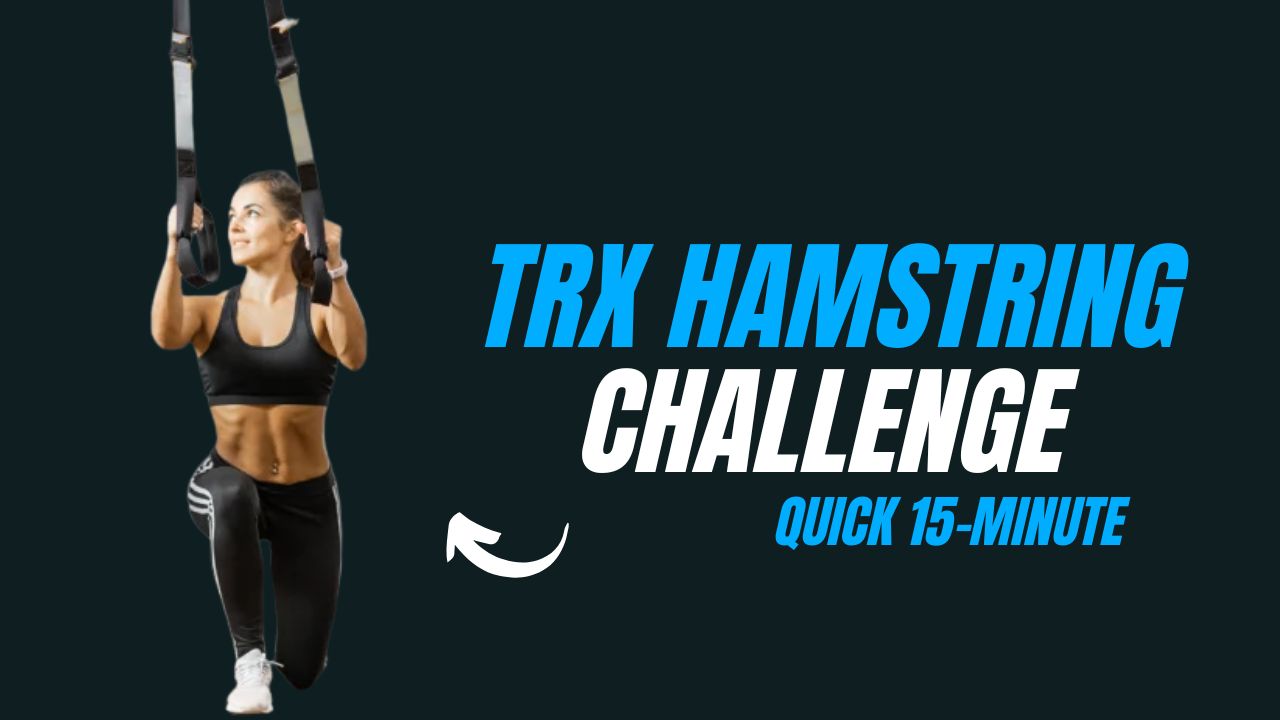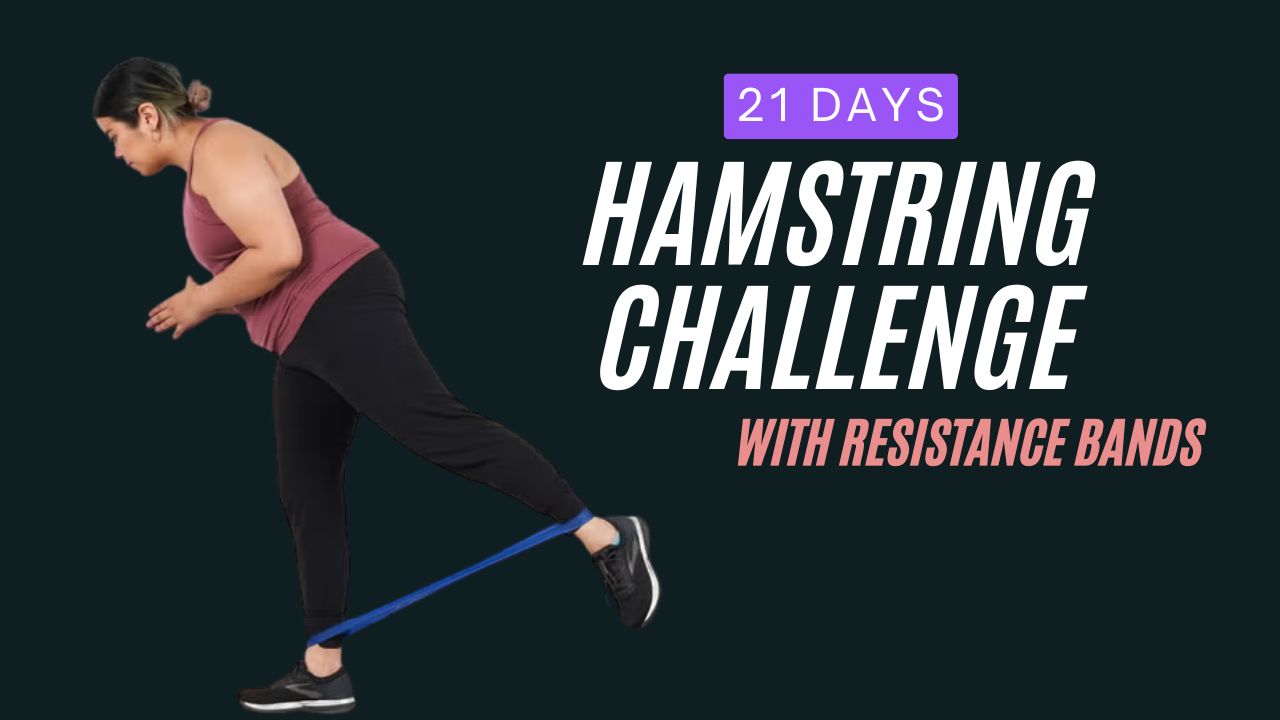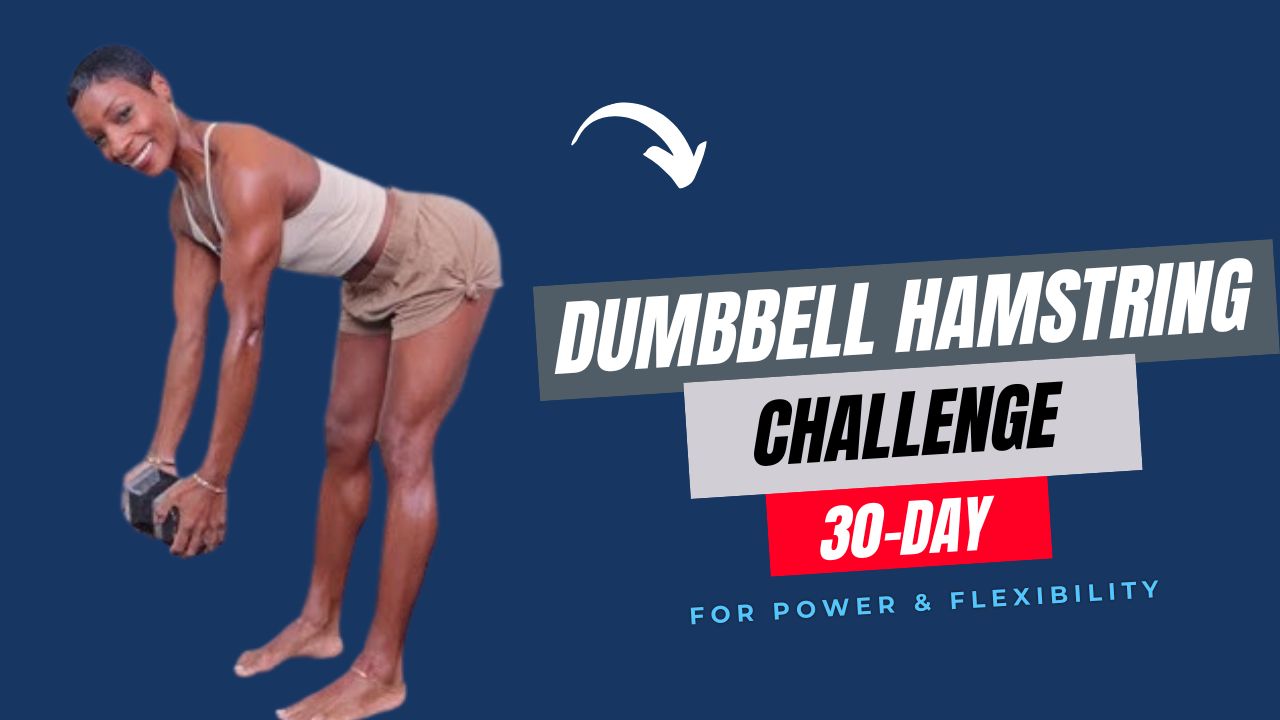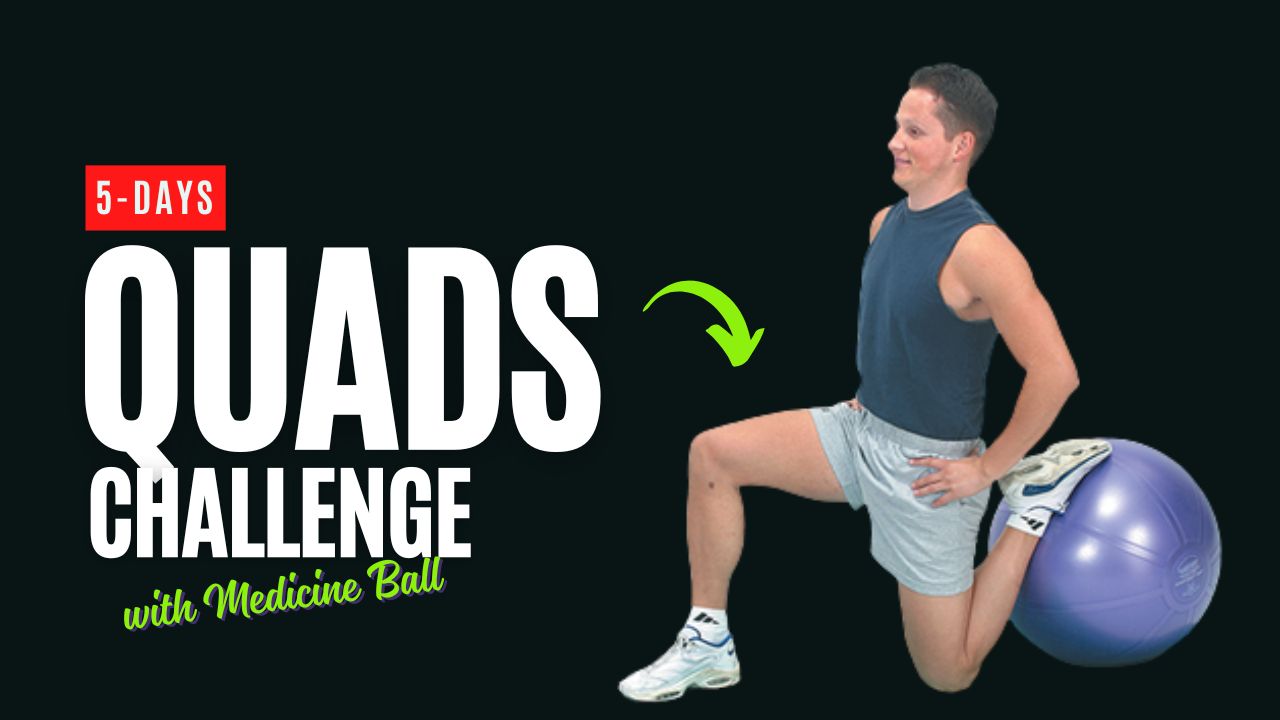Most people think strong legs are all about squats and quads, but here’s the truth—your hamstrings are the powerhouse behind explosive speed, balance, and injury prevention.
Surprisingly, weak hamstrings are one of the leading causes of knee and lower back problems. Do you know that your hamstrings make up nearly one-third of the muscles in your legs, yet they are the most commonly neglected?
This 45-minute kettlebell workout is designed to specifically target, strengthen, and sculpt your hamstrings.
Whether you’re an athlete looking to improve sprint speed, someone aiming to avoid nagging injuries, or just want leaner, stronger legs, the kettlebell hamstring challenge provides an efficient and functional way to achieve your goals.
In this guide, you’ll learn step-by-step “how-to” instructions for each exercise, discover why it works, and finally follow a structured 45-minute challenge routine.
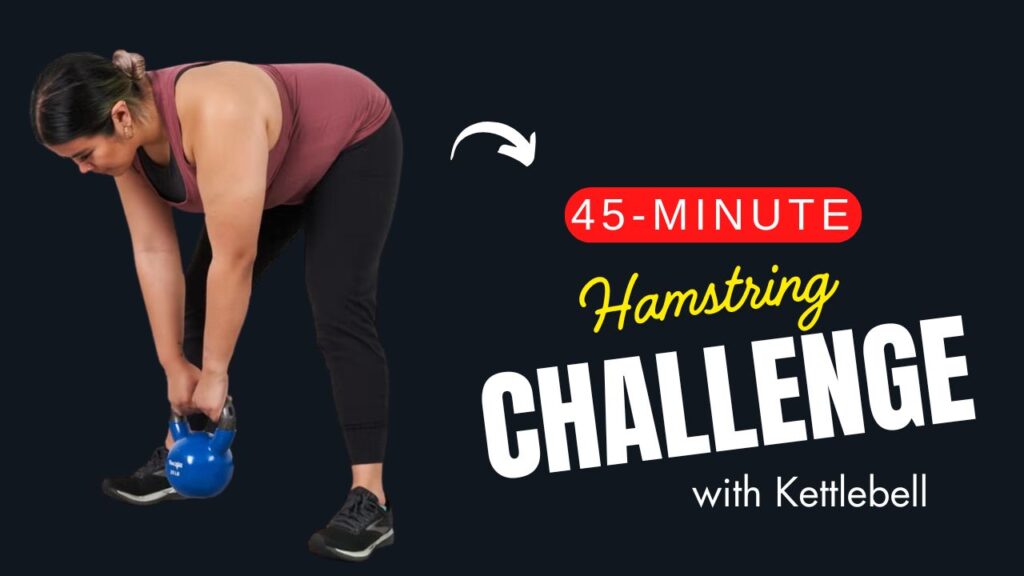
Table of Contents
Benefits of Kettlebell Training for Hamstrings
Before diving into the exercises, let’s understand why kettlebells are such a powerful tool:
- Functional strength: Builds strength that translates into daily movements like bending, sprinting, and lifting.
- Posterior chain development: Kettlebells naturally activate the hamstrings, glutes, and lower back together.
- Explosiveness & power: Perfect for athletes who rely on speed and agility.
- Reduced injury risk: Balanced hamstring strength prevents strain and supports knee stability.
What Can Happen After 30 Days of This Workout
| Positive Outcomes | Why It Happens |
|---|---|
| Noticeable hamstring strength increase | Consistent kettlebell hip hinge movements progressively overload the muscles. |
| Improved muscle tone and definition in the back of the legs | Targeted exercises like deadlifts and swings sculpt lean muscle. |
| Better posture and reduced lower back tension | Strong hamstrings balance out the posterior chain, relieving back strain. |
| Enhanced athletic performance (running, jumping, sprinting) | Explosive kettlebell swings and single-leg work improve speed and agility. |
| Greater flexibility and stability | Exercises like single-leg RDLs enhance balance and hamstring mobility. |
| Reduced risk of injury | Strong, conditioned hamstrings support knee and hip stability. |
| Increased workout confidence and endurance | Training regularly builds stamina and familiarity with kettlebell techniques. |
Do’s and Don’ts for Kettlebell Hamstring Training
| Do’s | Don’ts |
|---|---|
| Warm up before starting (5 minutes of dynamic stretches and mobility work). | Don’t lift heavy weights without mastering proper form first. |
| Focus on hip hinging rather than bending your lower back. | Don’t round your spine during deadlifts or swings. |
| Start with a manageable kettlebell weight and progress gradually. | Don’t jump to excessively heavy weights too soon. |
| Engage your core and keep your chest open for stability. | Don’t let your shoulders collapse forward. |
| Perform movements in a controlled manner, especially on the lowering phase. | Don’t rush through reps or use momentum over technique. |
| Rest 30–45 seconds between sets for recovery. | Don’t skip rest breaks; fatigue leads to poor form and injury risk. |
| Stretch and cool down after finishing the workout. | Don’t neglect recovery, as it limits growth and flexibility. |
| Train consistently 2–3 times per week for best results. | Don’t train hamstrings daily — overtraining can cause strain. |
8 Kettlebell Exercises for Stronger Hamstrings
1. Kettlebell Deadlift
The classic kettlebell deadlift is a foundation exercise that directly targets the hamstrings and glutes.
How to do it:
- Place a kettlebell between your feet. Stand with feet shoulder-width apart.
- Hinge at your hips (not your back) and grasp the kettlebell handle with both hands.
- Keep your spine neutral, shoulders back, and chest open.
- Drive through your heels as you extend your hips and stand tall.
- Lower the kettlebell back down with control.
Why it works: This movement lengthens and strengthens the hamstrings through hip hinging while also training proper lifting mechanics.
2. Single-Leg Romanian Deadlift (RDL)
The single-leg RDL adds balance and stability training while isolating each hamstring individually.
How to do it:
- Hold a kettlebell in your right hand.
- Stand tall with feet hip-width apart, then lift your left leg slightly behind you.
- Hinge forward at the hips while keeping your right knee slightly bent.
- Extend your left leg straight back as your torso lowers.
- Once the kettlebell reaches shin height, return to standing by squeezing your right glute and hamstring.
Why it works: Improves unilateral hamstring strength, corrects muscle imbalances, and enhances stability.
3. Kettlebell Swing
A dynamic movement that builds power, endurance, and posterior chain strength.
How to do it:
- Place the kettlebell about one foot in front of you.
- Hinge at the hips, grab the kettlebell, and hike it back between your legs.
- Drive your hips forward explosively, swinging the kettlebell to chest height.
- Control the descent and let the kettlebell swing back between your thighs.
- Repeat in a fluid, powerful motion.
Why it works: Swings build explosive hip drive and endurance while hammering the hamstrings with every rep.
4. Kettlebell Good Morning
A slow, controlled hamstring stretch-strength exercise.
How to do it:
- Hold a kettlebell against your chest (goblet position).
- Stand tall with feet shoulder-width apart.
- Hinge at the hips slowly, pushing them backward while keeping your spine neutral.
- Lower until you feel a stretch in your hamstrings.
- Return to the upright position with hamstring contraction.
Why it works: Strengthens hamstrings in a lengthened position, improving flexibility and resilience.
5. Kettlebell Step-Up
Step-ups emphasize single-leg strength while engaging hamstrings and glutes.
How to do it:
- Hold a kettlebell in goblet position at chest height.
- Place your right foot on a sturdy bench or box.
- Drive through your right heel, engaging hamstrings and glutes as you rise.
- Step down slowly with control.
- Repeat on both legs.
Why it works: Adds functional strength while challenging balance and coordination.
6. Kettlebell Hamstring Curl (Floor Version)
A lesser-known but effective hamstring isolation move.
How to do it:
- Lie on your back with your heels resting inside the handle of two kettlebells.
- Keep your arms by your side for support.
- Press hips into a bridge position.
- Slowly pull the kettlebells toward your glutes by curling your hamstrings.
- Extend back out with control.
Why it works: Direct hamstring isolation that mimics gym machine curls but with functional free weights.
7. Kettlebell Swing to Deadlift Combo
A hybrid exercise combining power and strength.
How to do it:
- Perform one kettlebell swing.
- After the kettlebell drops between your legs, let it rest on the ground.
- Transition immediately into a kettlebell deadlift.
- Repeat in sequence: swing → deadlift → swing.
Why it works: Builds explosive and controlled strength while keeping hamstrings under constant tension.
8. Kettlebell Bulgarian Split Squat
Although quad-dominant, the elevated leg position deeply recruits the hamstrings and glutes.
How to do it:
- Stand with your back foot elevated on a bench or step.
- Hold kettlebells in each hand at your sides.
- Lower your back knee toward the floor while keeping your front shin vertical.
- Drive up through your front heel to return to standing.
- Perform equal reps on both legs.
Why it works: Strengthens hamstrings and glutes while improving single-leg stability.
Myth vs. Fact: Hamstrings in Training
- Myth: Squats are enough for hamstrings.
- Fact: Squats primarily target quads. Hamstrings need direct hip-hinge movements like deadlifts and swings.
- Myth: Stretching alone prevents hamstring injuries.
- Fact: Strengthening hamstrings is just as important as flexibility to stay injury-free.
45-Minute Kettlebell Hamstring Workout Challenge
Here’s how you can put all these exercises into a structured 45-minute routine. The workout is divided into circuits to maximize both strength and endurance.
Routine Breakdown
- Warm-up: 5 minutes dynamic stretching (leg swings, hip circles, bodyweight good mornings).
- Main Workout: 35 minutes circuit training (3 circuits).
- Cool-down: 5 minutes stretching (hamstring stretches, pigeon pose, foam rolling if available).
Circuit Table
| Exercise | Sets | Reps/Time | Rest |
|---|---|---|---|
| Kettlebell Deadlift | 3 | 12 reps | 30 sec |
| Single-Leg Romanian Deadlift | 3 | 10 reps per leg | 30 sec |
| Kettlebell Swing | 4 | 15 reps | 30 sec |
| Kettlebell Good Morning | 3 | 12 reps | 30 sec |
| Kettlebell Step-Up | 3 | 12 reps per leg | 30 sec |
| Kettlebell Hamstring Curl | 3 | 10 reps | 30 sec |
| Kettlebell Swing to Deadlift Combo | 3 | 8 reps | 30 sec |
| Kettlebell Bulgarian Split Squat | 3 | 10 reps per leg | 45 sec |
Conclusion
Your hamstrings are more than just supportive muscles — they are essential drivers of strength, speed, and stability.
Neglecting them can lead to muscle imbalances, reduced athletic performance, and a higher risk of injuries. With this 45-minute kettlebell workout, you now have a structured routine that not only sculpts leaner hamstrings but also builds lasting strength and resilience.
Consistency is the real secret. The more regularly you train your hamstrings with functional movements like swings, deadlifts, and single-leg variations, the more noticeable the improvements will be in your posture, athletic power, and overall lower-body definition.
Challenge Continuation Idea
Once you’ve completed this 45-minute kettlebell hamstring workout for 4–6 weeks, don’t stop there — progress is about gradual overload and variety. Here are some ways to continue the challenge:
- Increase Weight – Move up to a heavier kettlebell to keep your muscles adapting.
- Add Time Under Tension – Perform slower negatives (eccentric lowering) in deadlifts and good mornings.
- Include Plyometric Moves – Add kettlebell jump squats or swing-to-burpees for explosive hamstring training.
- Weekly Ladder Challenge – Each week, add 2–3 reps per exercise while maintaining form.
- Endurance Phase – Instead of counting reps, use a timer (e.g., 40 seconds work / 20 seconds rest per exercise).
Think of this not just as a 45-minute workout but as the foundation of an 8-week hamstring sculpting program. By progressively challenging yourself, you’ll avoid plateaus and keep building strength, stability, and athletic performance long after the first month.
Frequently Asked Questions (FAQs)
Can beginners do this 45-minute kettlebell hamstring workout?
Yes. Beginners should start with a lighter kettlebell (8–12 kg) and focus on proper form rather than heavy weight. It’s better to master technique before progressing to more challenging loads.
How often should I train my hamstrings with kettlebells?
For best results, include this workout 2–3 times per week with at least one rest or light activity day in between sessions. This allows your muscles to recover and grow stronger.
How long does it take to see results?
Most people notice improvements in strength and stability within 4–6 weeks, and visible changes in muscle tone after 6–8 weeks, depending on consistency, nutrition, and overall fitness routine.
What kettlebell weight is best for hamstring workouts?
Men often start with 12–16 kg kettlebells, while women typically begin with 8–12 kg. However, the “right” weight is one that challenges you while still allowing proper form throughout the workout.
Can I do this workout at home without a gym?
Absolutely. All exercises in this routine require only kettlebells and minimal space, making it ideal for both home and gym workouts.
Will kettlebell training make my legs bulky?
Not necessarily. Kettlebell training builds lean muscle and functional strength. For most people, it tones and defines the legs rather than adding bulk.
Are kettlebell swings safe for hamstrings?
Yes, when performed with proper hip hinge form. They strengthen the hamstrings dynamically and improve explosive power. If you have lower back pain, start slow and focus on controlled movement before building speed.
Can this workout replace leg day completely?
This kettlebell hamstring workout heavily targets the posterior chain but doesn’t fully replace other leg-day movements like squats and lunges. It’s best used as a focused hamstring session or as part of a complete lower-body routine.
Do I need to stretch after the workout?
Yes. Stretching helps relieve muscle tension, improves flexibility, and aids recovery. Include hamstring stretches, hip flexor stretches, and glute stretches after each session.
Can this workout help with running speed?
Definitely. Stronger hamstrings improve sprinting performance, acceleration, and reduce the risk of hamstring pulls, making this routine highly beneficial for athletes and runners.





